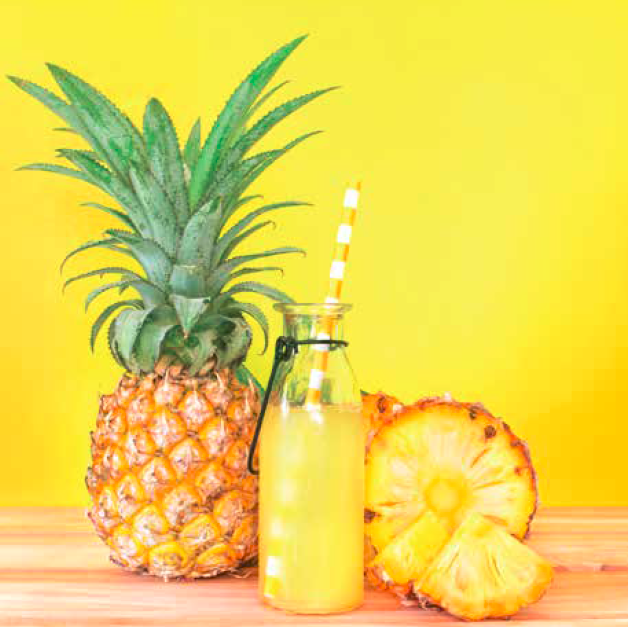
The pineapple (Ananas comosus) is a tropical plant with an edible fruit, also called a pineapple, and the most economically significant plant in the family Bromeliaceae. The pineapple is indigenous to South America, where it has been cultivated for many centuries. The introduction of the pineapple cultivation to Europe in the 17th century made it a significant cultural icon of luxury. Since the 1820s, pineapple has been commercially grown in greenhouses and many tropical plantations. Further, it is the third most important tropical fruit in world production. In the 20th century, Hawaii was a dominant producer of pineapples, especially for the US; however, by 2016, Costa Rica, Brazil, and the Philippines accounted for nearly one-third of the world’s production of pineapples.
Pineapples grow as a small shrub; the individual flowers of the unpollinated plant fuse to form a multiple fruit. The plant is normally propagated from the offset produced at the top of the fruit, or from side shoot, and typically mature within a year.
History
The wild plant originates from the Paraguay River drainages between southern Brazil and Paraguay. Little is known about domestication but it spread as a crop throughout South America, and it eventually reached the Caribbean, Central America, and Mexico, where it was cultivated by the Mayas and the Aztecs. The first European to encounter the pineapple was Columbus, in Guadeloupe on 4 November 1493, by which time cropped pineapple was a widely distributed and a stable component of the diet of native Americans. The Portuguese took the fruit from Brazil and introduced it into India by 1550. The ‘Red Spanish’ cultivar was also introduced by the Spanish from Latin America to the Philippines, and it was grown for textile use from at least the 17th century.
Columbus brought the plant back to Spain and called it piña de Indes, meaning “pine of the Indians”. The pineapple was documented in Peter Martyr’s Decades of the New World in 1516 and Antonio Pigafetta’s Le Voyage et Navigacion.. of 1526, and the first known illustration was in Oviedo’s Historia General de Las Indias in 1535.
The pineapple fascinated Europeans as a fruit of colonialism but it could not be successfully cultivated in Europe for several centuries until Pieter de la Court developed a greenhouse horticulture near Leyden from about 1658. Pineapple plants were distributed from the Netherlands to English gardeners in 1719 and French ones in 1730. In England, the first pineapple was grown at Dorney Court, Dorney in Buckinghamshire, and a huge “pineapple stove” to heat the plants was built at the Chelsea Physic Garden in 1723. In France, King Louis XV was presented with a pineapple that had been grown at Versailles in 1733. In Russia, Catherine the Great ate pineapples grown on her own estates before 1796. Because of the expense of direct import and the enormous cost in equipment and labour required to grow them in a temperate climate, using hothouses called “pineries”, pineapples soon became a symbol of wealth. They were initially used mainly for display at dinner parties, rather than being eaten, and were used again and again until they began to rot. By the second half of the 18th century, the production of the fruit on British estates had become the subject of great rivalry between wealthy aristocrats. John Murray, 4th Earl of Dunmore built a hothouse on his estate surmounted by a huge stone cupola 14 metres tall in the shape of the fruit; it is known as the Dunmore Pineapple. In architecture, pineapple figures became decorative elements symbolizing hospitality.
Many different varieties were tried, mostly from the Antilles, for European glasshouse cultivation.The most significant was ‘Smooth Cayenne’, imported to France in 1820, and subsequently re-exported to the UK in 1835 and then from the UK via Hawaii to Australia and Africa. `Smooth Cayenne” is now the dominant cultivar in world production. Jams and sweets based on pineapple were being imported to Europe from the West Indies, Brazil and Mexico from an early date, and by the early 19C, fresh pineapples were transported direct from the West Indies in large enough quantities to reduce European prices. Later pineapple production was dominated by the Azores for Europe and Florida and the Caribbean for North America because of the short trade routes.
The Spanish had introduced the pineapple into Hawaii in the 18th century, but the first commercial plantation was not until 1886. The most famous investor was James Dole, who moved to Hawaii in 1899 and started a 60 acres (24 ha) pineapple plantation in 1900 which would grow into the Dole Food Company. Dole and Del Monte began growing pineapples on the island of Oahu in 1901 and 1917, respectively, and the Maui Pineapple Company began cultivation on Maui in 1909. James Dole began the commercial processing of pineapple and an automatic peeling and coring machine was developed by Henry Ginaca, a Dole employee, in 1911.
Hawaiian production started to decline from the 1970s because of competition and the shift to refrigerated sea transport. Dole ceased its cannery operations in Honolulu in 1991, and in 2008, Del Monte terminated its pineapple-growing operations in Hawaii. In 2009, the Maui Pineapple Company reduced its operations to supply pineapples only locally on Maui, and by 2013, only the Dole Plantation on Oahu grew pineapples in a volume of about 0.1 percent of the world’s production. Despite this decline the pineapple is sometimes used as a symbol of Hawaii and foods with pineapple in them are sometimes known as “Hawaiian” for this reason alone.
In the Philippines, ‘Smooth Cayenne’ was introduced in the early 1900s by the US Bureau of Agriculture during the American colonial period, and Dole and Del Monte also established plantations in the island of Mindanao in the 1920s; in the provinces of Cotabato and Bukidnon, respectively. Large scale canning had started in Southeast Asia, including in the Philippines, from 1920 although this trade was severely damaged by the Second World War, and Hawaii dominated the international trade until the 1960s.
The Philippines remain one of the top exporters of pineapples in the world. The Del Monte plantations are now locally managed, after Del Monte Pacific Ltd., a Filipino company, completed the purchase of Del Monte Foods in 2014.
Nutrition
Raw pineapple pulp is 86% water, 13% carbohydrates, 0.5% protein, and contains negligible fat (table). In a 100-gram reference amount, raw pineapple supplies 50 calories, and is a rich source of manganese (44% Daily Value, DV) and vitamin C (58% DV), but otherwise contains no micronutrients in significant amounts.

